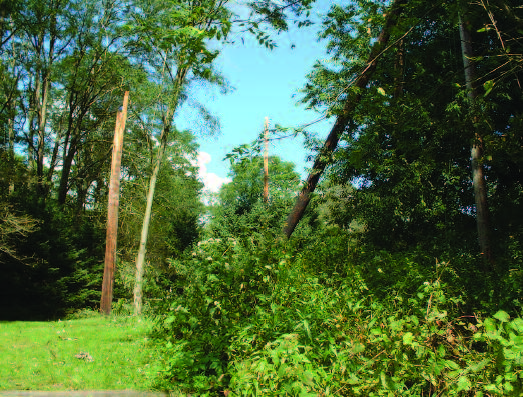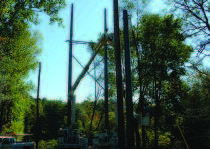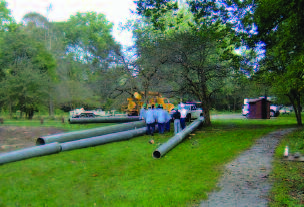
The span across the Allegheny River at the Buckaloons, placed back in the 1950s, was already scheduled to be replaced. However, one of Mother Nature’s strong fall windstorms put this project on the fast track.
The windstorm took down three old wooden poles on each side of the river, bringing down the 590-foot span and disrupting service along Route 337 for about 10 miles and along Route 62 for about eight miles. Power was rerouted through the Whig Hill substation, with very few voltage issues, even during the heavy draw from manufacturing plants in the area.

Warren Electric Cooperative (WEC) stepped into the future by using poles that are recycled fiber/resin, 70 feet in length and 5,000 pounds in weight, but telescopic for easier transportation, fewer highway permits and efficient installation. They are environmentally friendly, cost effective and fireproof, with a 100-year lifespan. Fiber/resin poles are one-third the weight of wooden poles.
“WEC linemen enjoyed the challenge of this new technology,” notes Chris Evans, system engineer. “The poles arrived quickly on site with technicians provided to train the linemen on installation. This was the first use of these fiber/resin poles in Pennsylvania.”

Materials were received in about two weeks, training took four days and the span was replaced and in service in two weeks.
Traditional utility poles have distinct disadvantages. Wooden utility poles are probably the most common utility pole in use today, followed by concrete and steel. Wooden utility poles are susceptible to rot or destruction because of weather and bug infestation. To prevent the destruction of the poles, many wooden poles are soaked in creosote. However, WEC does not use creosote. There are safer choices of wood preservative treatments including: Penta (pentachlorophenol, a pesticide), CCA (Chromated Copper Arsenate, rendering the wood fiber useless as a food source for fungi and termites) and ET (Emulsion Treated, a lubrication oil).
Creosote is a highly toxic substance that has possible links to cancer in humans. The creosote can leech out of poles onto the ground and eventually end up polluting water sources. Even with the creosote application, wooden poles still have a limited life span, and they need extensive maintenance and routine replacement.
Concrete poles have been used in place of wood in some places. Unfortunately, concrete poles are extremely heavy and often require a crane or special machinery to assemble the pole in the field. Also, these poles are a problem in remote locations because the weight of the pole requires the use of heavy trucks to transport them.
Steel poles are lighter than concrete, but remain burdensome and are susceptible to environmental factors, like rust. Steel poles also can present a danger to people working on or near the poles. (Information from www.wipo.int)
